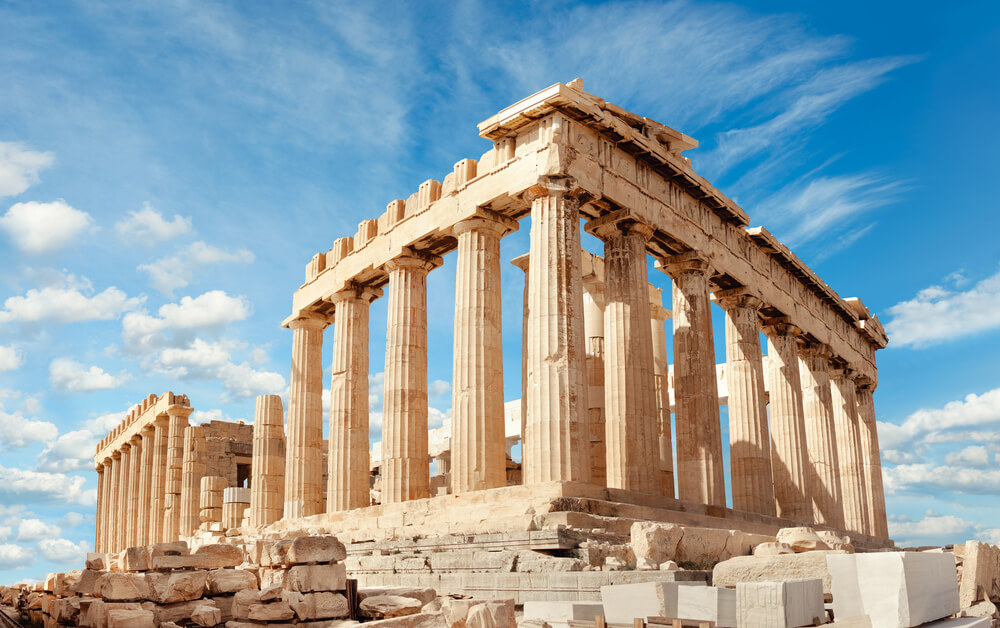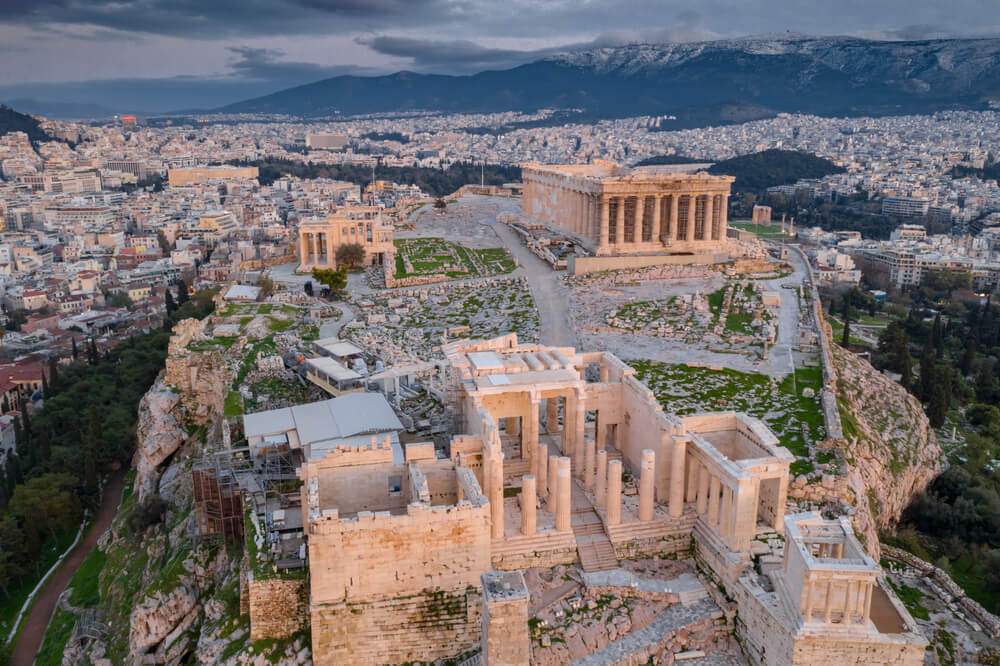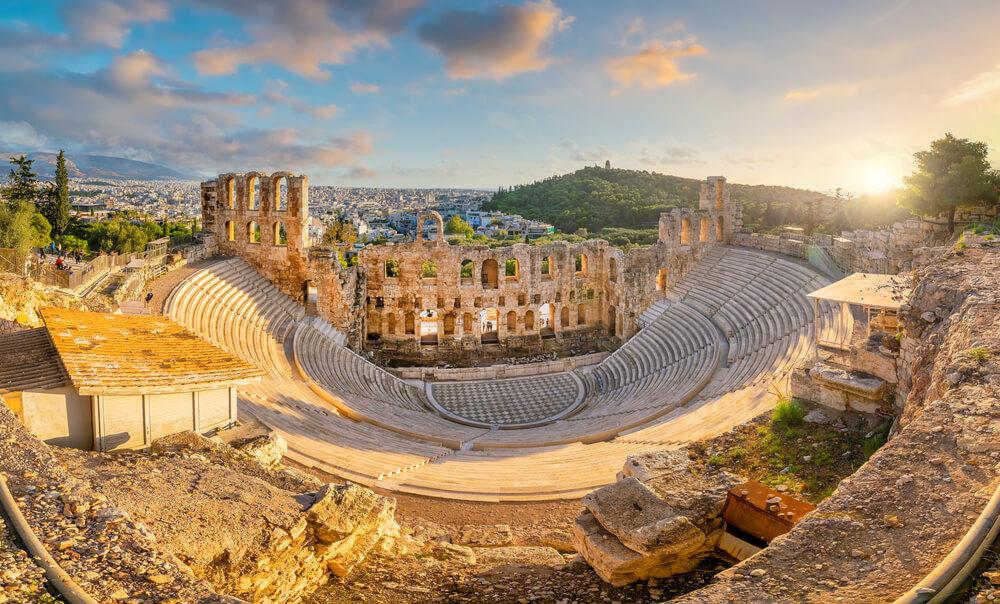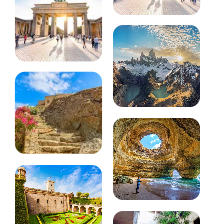Immerse yourself in the Acropolis of Athens: advice and practical information

The Acropolis: a universal symbol
The Acropolis is a group of different monuments dating back to ancient times, situated on a rocky plateau 156 metres high. The word “acropolis” comes from the combination of the words “ákros” – meaning high, elevated – and “pólis” – meaning city. The acropolis is therefore the high city. Occupied since Neolithic times, this hill was considered an acropolis from the 13th century BC, when a wall was built around the site. Some of the remains can still be seen today.
It is made up of the ruins of numerous ancient sites, including the Parthenon, the Erechtheion, the temple of Athena Nike, the Propylaea, the sanctuary of Artemis Brauronia, the Theatre of Dionysus and the Odeon of Herod Atticus. The Parthenon, the Acropolis’ most imposing landmark, was built over 2,500 years ago.
The legend of Athens
The history of Athens is closely linked to that of the goddess Athena. According to legend, it was she who gave the city its name. Indeed, it was after a confrontation with the god of the seas, Poseidon, that she became the deity associated with the city. And it was on this hill, which today reveals the greatest remains of Greece, that the battle is said to have taken place. This is why most of the monuments erected there are in honour of this goddess of wisdom and war and have become a sacred site.
How do I visit the Acropolis in Athens?
1- Getting to the Acropolis
You can walk to the Acropolis from Athens city centre. There are two entrances: the first, the main one, is on Dionysiou Areopagitou Street, and the second, which is often a little less busy, is via the Theatre of Dionysus, opposite the Acropolis Museum.
By metro, take line 2 and get off at the Acropoli stop. You will then be directed to the entrance.
2- What can you see at the Acropolis?
The Parthenon: this is the largest monument you will see on the Acropolis. It was built between 447 and 432 BC, and has stood on the hill for almost 2,500 years. It is the symbol of the freedom of Athens, having been built after the Athenians succeeded in driving the Persians from their territory. Dedicated to Athena, its dimensions are exceptional: 70 metres long and 30 metres wide. It is made up of 46 columns over 10 metres high. It is the largest Greek temple of the classical era.
In the 13th century, it became a Christian church when the Byzantines took control of Greece, and then a mosque for several centuries when the Ottoman Empire took control of the territory. In the 17th century, it was even used as an ammunition depot, resulting in a major explosion that caused extensive damage. Although it has suffered a great deal of damage over the centuries, it has nevertheless managed to stand the test of time and today reveals some impressive remains. In 1975, a restoration project was launched and the Greek government transformed the Acropolis into a tourist attraction open to the public.
Originally, the Parthenon was replaced by an ancient temple that was destroyed by the Persians. When the Greeks regained control of their territory, they were left with a large sum of money that had been earmarked for fighting the Persians. It was with this money that the Parthenon was built, to embellish the city and to serve both as a temple dedicated to Athena and as a treasury, where what money remained after its construction was deposited. This is how the Parthenon came into being!
The Erechtheion: this monument, which dates from the end of the 5th century BC, stands on the site of the dispute between Athena and Poseidon over the territory of Athens. It is therefore dedicated to the former, the goddess of wisdom and war, and is the most sacred site on the Acropolis.
The temple of Athena Nikè: built in 420 BC, this temple bears the name of the city’s patron goddess, to which is added the word “nikè”, meaning victory. Built against the backdrop of the Peloponnesian War, it was probably erected in the hope that Athens would emerge victorious from the conflict.
The Propylaea: these are the first remains you will see when you arrive at the Acropolis. The Propylaea were built to mark the entrance to the Acropolis: five monumental gates, the central one of which gave access to the Sacred Way, the main road to the Acropolis. However, they were never completed. In the 12th century, however, it became the Byzantine episcopal palace.
The Theatre of Dionysus: considered to be the world’s first theatre, it, like the rest of the Acropolis, dates back to the 5th century BC. It is also the largest theatre ever built by the ancient Greeks, once seating 17,000. It is dedicated to Dionysus, the god of wine and theatre.
Did you know? The Parthenon is now the most reproduced monument in the world. It was the inspiration for the construction of the Supreme Court of the United States, the White House, the Madeleine church in Paris, the Ivan Vazov theatre in Bulgaria and the Palais de Justice in Bordeaux.
Things to know before you visit: it’s quite possible that there will be cranes and scaffolding all over the Acropolis during your visit. Unfortunately, this is unavoidable, as a great deal of work is constantly being carried out to ensure the long-term survival and renovation of the site. The statues, sculptures and bas-reliefs are often reconstructions, the originals being carefully preserved and exhibited in the Acropolis Museum, protected from pollution and the elements that could damage them.
3- How do I visit the Acropolis?
It takes around 2 hours to visit the Acropolis. There are a number of different ways to explore this superb site:
You can choose to visit the Acropolis on your own.
If you want as much information as possible, there are private or group guided tours, sometimes on the theme of mythology, in French. Don’t hesitate to find out all about the different options and choose the tour that suits you best!
If you’re visiting with children, you can opt for a more playful approach, with a smartphone application or organised treasure hunt, for example. Several structures offer this.
In all cases, for a guided tour or a treasure hunt, you should book in advance to be sure of space and organisation.
4- When to visit? Practical advice and information
As you’ll see, the most common advice for visiting the Athens Acropolis is not to go during the summer! Firstly, because it’s obviously very crowded, but also because summer in Athens can be very hot and stifling! Temperatures often rise above 30°C and on a site like the Acropolis, there is virtually no shade. If you visit Athens in summer, I can only advise you to go to the Acropolis early in the morning or late in the afternoon to avoid both the crowds and the heat. Don’t forget to take a bottle of water with you. And beware: when the temperature is over 39°C, the Acropolis is closed to visitors between 1pm and 5pm!
If you want to be able to visit the site in peace, it’s best to arrive in the morning when it opens or in the afternoon, around 2 hours before it closes.
Don’t forget to bring comfortable shoes that are easy to walk in, as the Acropolis is high up and you often have to walk over rocks to reach one of the monuments. Be careful, some of the rocks can even be slippery!
Leave your large bag/luggage at your accommodation; you will only be allowed in with a small rucksack or handbag!
5- Opening times and prices
Admission to the Acropolis depends on the season… :
- Between April and the end of October: €20 per person
- Between November and the end of March: €10 per person
… and yourage ! :
- Free for under-25s from EU countries
- Free for all under-5s
- Free for students from the EU
- Free for people with disabilities
- 10 for over-65s (regardless of the season)
Please note that you must go through the ticket office to benefit from a reduced rate or a free ticket, and show the necessary supporting documents.
Tip: if you’re spending several days in Athens and plan to visit several of its tourist sites, take a combined ticket! It costs €30 per person and gets you into the Acropolis, the Ancient Agora, the Roman Agora, the Temple of Zeus (Olympiion), Hadrian’s Library, the Lykeion site and the Keramikos site. You’ll save over thirty euros! It is valid for 5 days and can be purchased at any of these sites. You can also use it as a barrier-free ticket.
Please note: with the combined ticket, you can only visit each site once. The Acropolis Museum is not included and must be purchased separately directly from the museum.
Entry to the Acropolis is free for all on certain dates:
- 6 March
- 18 April: International Monuments Day
- 18 May: International Museum Day
- The last weekend in September: Heritage Days
- 28 October: Greek National Day
- Every first Sunday of the month between November and March!
Please note that the Acropolis is closed on 1 January, 25 March, 1 May, Easter Sunday and 25 and 26 December!
Opening times also vary according to the season:
- Summer (April to the end of October): 8am-8pm
- Winter (November to the end of March): 8am-5pm
In all cases, you can enter the site up to 30 minutes before closing time. Be aware, however, that if you arrive 30 minutes before closing time, you won’t have time to do the tour as you’ll already have to go back down. Allow at least 1h30, even for a quick visit.
6- Access for people with reduced mobility
Some areas are accessible to people with reduced mobility. A lift is also available to enable disabled visitors to enter the Acropolis and begin their visit.
7- The Acropolis Museum
Opposite one of the entrances to the Acropolis is a museum that traces the history of this iconic Greek hill. Unfortunately, the visit is not included in the ticket for the Acropolis, so you need to buy a ticket from the museum to visit it. But it’s worth combining the two to get a complete overview and explanation of this not-to-be-missed site!
In conclusion
Whether on a guided tour or on your own, the Acropolis is a must-see site if you spend any time in Athens. Some of the greatest remains of Greek antiquity open their doors to you for a real leap into the past, between myth and reality. A jewel of architecture and history that has survived the centuries to become one of the most visited sites in Greece!
200 audioguided tours for cities all around the world
Download



